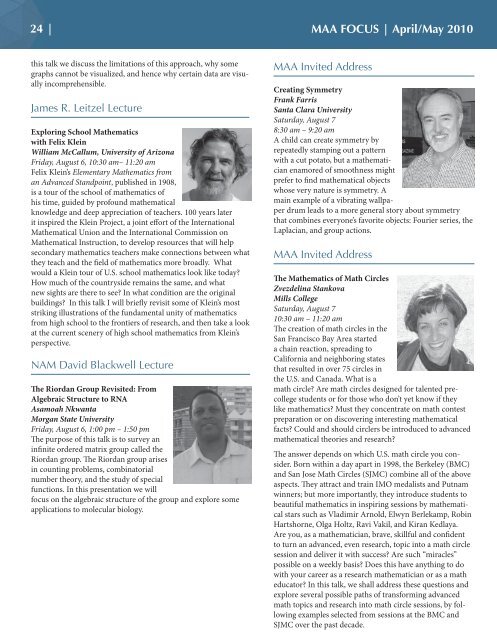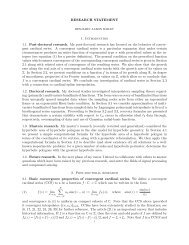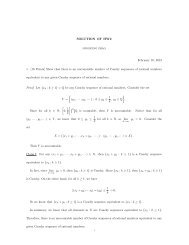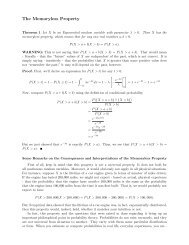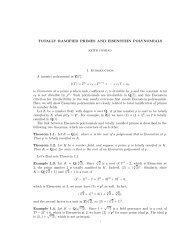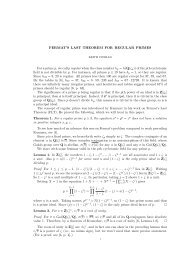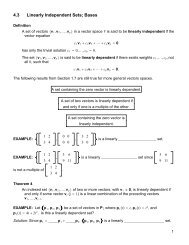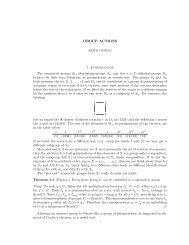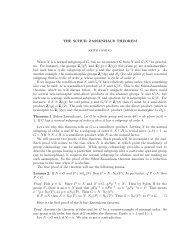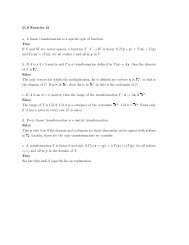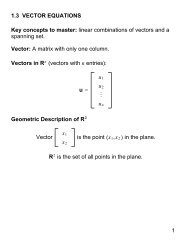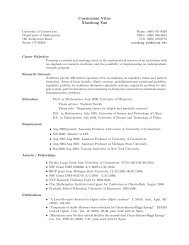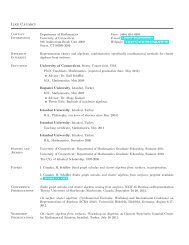April/May 2010 - Department of Mathematics - University of ...
April/May 2010 - Department of Mathematics - University of ...
April/May 2010 - Department of Mathematics - University of ...
Create successful ePaper yourself
Turn your PDF publications into a flip-book with our unique Google optimized e-Paper software.
�� �<br />
this talk we discuss the limitations <strong>of</strong> this approach, why some<br />
graphs cannot be visualized, and hence why certain data are visually<br />
incomprehensible.<br />
����� �� ������� �������<br />
Exploring School <strong>Mathematics</strong><br />
with Felix Klein<br />
William McCallum, <strong>University</strong> <strong>of</strong> Arizona<br />
Friday, August 6, 10:30 am– 11:20 am<br />
Felix Klein’s Elementary <strong>Mathematics</strong> from<br />
an Advanced Standpoint, published in 1908,<br />
is a tour <strong>of</strong> the school <strong>of</strong> mathematics <strong>of</strong><br />
his time, guided by pr<strong>of</strong>ound mathematical<br />
knowledge and deep appreciation <strong>of</strong> teachers. 100 years later<br />
it inspired the Klein Project, a joint e� ort <strong>of</strong> the International<br />
Mathematical Union and the International Commission on<br />
Mathematical Instruction, to develop resources that will help<br />
secondary mathematics teachers make connections between what<br />
they teach and the � eld <strong>of</strong> mathematics more broadly. What<br />
would a Klein tour <strong>of</strong> U.S. school mathematics look like today?<br />
How much <strong>of</strong> the countryside remains the same, and what<br />
new sights are there to see? In what condition are the original<br />
buildings? In this talk I will brie� y revisit some <strong>of</strong> Klein’s most<br />
striking illustrations <strong>of</strong> the fundamental unity <strong>of</strong> mathematics<br />
from high school to the frontiers <strong>of</strong> research, and then take a look<br />
at the current scenery <strong>of</strong> high school mathematics from Klein’s<br />
perspective.<br />
��� ����� ��������� �������<br />
� e Riordan Group Revisited: From<br />
Algebrai c Structure to RNA<br />
Asamoah Nkwanta<br />
Morgan State <strong>University</strong><br />
Friday, August 6, 1:00 pm – 1:50 pm<br />
� e purpose <strong>of</strong> this talk is to survey an<br />
in� nite ordered matrix group called the<br />
Riordan group. � e Riordan group arises<br />
in counting problems, combinatorial<br />
number theory, and the study <strong>of</strong> special<br />
functions. In this presentation we will<br />
focus on the algebraic structure <strong>of</strong> the group and explore some<br />
applications to molecular biology.<br />
��� ����� � �������<br />
��� ������� �������<br />
Creating Symmetry<br />
Frank Farris<br />
Sant a Clara <strong>University</strong><br />
Saturday, August 7<br />
8:30 am – 9:20 am<br />
A child can create symmetry by<br />
repeatedly stamping out a pattern<br />
with a cut potato, but a mathematician<br />
enamored <strong>of</strong> smoothness might<br />
prefer to � nd mathematical objects<br />
whose very nature is symmetry. A<br />
main example <strong>of</strong> a vibrating wallpaper<br />
drum leads to a more general story about symmetry<br />
that combines everyone’s favorite objects: Fourier series, the<br />
Laplacian, and group actions.<br />
��� ������� �������<br />
� e <strong>Mathematics</strong> <strong>of</strong> Math Circles<br />
Zvezdelina Sta nkova<br />
Mills College<br />
Saturday, August 7<br />
10:30 am – 11:20 am<br />
� e creation <strong>of</strong> math circles in the<br />
San Francisco Bay Area started<br />
a chain reaction, spreading to<br />
California and neighboring states<br />
that resulted in over 75 circles in<br />
the U.S. and Canada. What is a<br />
math circle? Are math circles designed for talented precollege<br />
students or for those who don’t yet know if they<br />
like mathematics? Must they concentrate on math contest<br />
preparation or on discovering interesting mathematical<br />
facts? Could and should circlers be introduced to advanced<br />
mathematical theories and research?<br />
� e answer depends on which U.S. math circle you consider.<br />
Born within a day apart in 1998, the Berkeley (BMC)<br />
and San Jose Math Circles (SJMC) combine all <strong>of</strong> the above<br />
aspects. � ey attract and train IMO medalists and Putnam<br />
winners; but more importantly, they introduce students to<br />
beautiful mathematics in inspiring sessions by mathematical<br />
stars such as Vladimir Arnold, Elwyn Berlekamp, Robin<br />
Hartshorne, Olga Holtz, Ravi Vakil, and Kiran Kedlaya.<br />
Are you, as a mathematician, brave, skillful and con� dent<br />
to turn an advanced, even research, topic into a math circle<br />
session and deliver it with success? Are such “miracles”<br />
possible on a weekly basis? Does this have anything to do<br />
with your career as a research mathematician or as a math<br />
educator? In this talk, we shall address these questions and<br />
explore several possible paths <strong>of</strong> transforming advanced<br />
math topics and research into math circle sessions, by following<br />
examples selected from sessions at the BMC and<br />
SJMC over the past decade.


